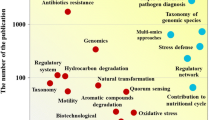Abstract
An obligately chemolithoautotrophic and aerobic hydrogen-oxidizing bacterium was isolated from a seaside saline hot spring in Izu Peninsula, Japan. The isolate was a Gram-negative, non-motile, non-spore-forming rod cell measuring 0.3 to 0.5 by 1.0 to 2.5 μm. The optimal temperature for growth was around 70°C, and no growth was observed at 40°C or 80°C. Elemental sulfur or thiosulfate could be an alternative to molecular hydrogen as the sole energy source. The DNA base composition of the isolate was 46.0 mol% G+C. 2-Methylthio-3-VI,VII-tetrahydromultiprenyl7-1,4-naphthoquinone (methionaquinone) was the major component of the quinone system. C18:0, C18:1 and C20:1 were the major components of the cellular fatty acids. These properties clearly indicate that the isolate belongs to genus Hydrogenobacter, but differed from H. thermophilus in some respects. Specifically, the isolate was a halophile which grew optimally at around 0.3–0.5 M NaCl, while H. thermophilus could not grow at such NaCl concentration levels. A new species name H. halophilus is proposed for this new halophilic isolate.
Similar content being viewed by others
References
Beatrice MC, Chappell JB (1979) The respiratory chain of Hydrogenomonas H16. Biochem J 178: 15–22
Bonjour F, Aragno M (1986) Growth of thermophilic, obligatorily chemolithoautotrophic hydrogen-oxidizing bacteria related to Hydrogenobacter with thiosulfate and elemental sulfur as electron and energy source. FEMS Microbiol Lett 35: 11–15
Conrad R, Bonjour F, Aragno M (1985) Aerobic and anaerobic microbial consumption of hydrogen in geothermal spring water. FEMS Microbiol Lett 29: 201–205
Ishii M, Igarashi Y, Kodama T (1987a) Colony formation of Hydrogenobacter thermophilus on a plate solidified with GELRITE. Agric Biol Chem 51: 3139–3141
Ishii M, Itoh S, Kawasaki H, Igarashi Y, Kodama T (1987b) The membrane-bound hydrogenase reduces cytochrome c552 in Hydrogenobacter thermophilus strain TK-6. Agric Biol Chem 51: 1825–1831
Ishii M, Kawasumi T, Igarashi Y, Kodama T, Minoda Y, (1987c) 2-Methylthio-1,4-naphthoquinone, a unique sulfur-containing quinone from a thermophilic hydrogen-oxidizing bacterium, Hydrogenobacter thermophilus. J Bacteriol 169: 2380–2384
Jannasch HW, Mottl MJ, (1985) Geomicrobiology of deep-sea hydrothermal vents. Science 229: 717–725
Jannasch HW, Taylor CD (1984) Deep-sea microbiology. Ann Rev Microbiol 38: 487–514
Kawasumi T, Igarashi Y, Kodama T, Minoda Y (1980) Isolation of strictly thermophilic and obligately autotrophic hydrogen bacteria. Agric Biol Chem 44: 1985–1986
Kawasumi T, Igarashi Y, Kodama T, Minoda Y (1984) Hydrogenobacter thermophilus gen. nov., sp. nov., and extremely thermophilic, aerobic, hydrogen-oxidizing bacterium. Int J Syst Bacteriol 34: 5–10
Kristjansson JK, Ingason A, Alfredsson GA (1985) Isolation of thermophilic obligately autotrophic hydrogen-oxidizing bacteria, similar to Hydrogenobacter thermophilus, from Icelandic hot springs. Arch Microbiol 140: 321–325
Kryukov VR, Savelyeva ND, Pusheva MA (1983) Calderobacterium hydrogenophilum nov. gen. nov. sp., an extreme thermophilic hydrogen bacterium, and its hydrogenase activity. Mikrobiologiya 52: 781–788
Marmur J (1961) A procedure for the isolation of deoxyribonucleic acid from micro-organisms. J Mol Biol 3: 208–218
Nishihara H, Igarashi Y, Kodama T (1989) Isolation of an obligately chemolithoautotrophic, halophilic and aerobic hydrogen-oxidizing bacterium from marine environment. Arch Microbiol 152: 39–43
Schink B, Lupton FS, Zeikus JG (1983) Radioassay for hydrogenase activity in viable cells and documentation of aerobic hydrogen-consuming bacteria living in extreme environments. Appl Environ Microbiol 45: 1491–1500
Shiba H, Kawasumi T, Igarashi Y, Kodama T, Minoda Y (1985) The CO2 assimilation via the reductive tricarboxylic acid cycle in an obligately autotrophic, aerobic hydrogen-oxidizing bacterium, Hydrogenobacter thermophilus. Arch Microbiol 141: 198–203
Takeda Y, Suzuki F, Inoue H (1969) ATP citrate lyase (citrate-cleavage enzyme). In: Lowenstein JM (ed) Methods in enzymology, vol. 13, Academic Press, New York, pp 153–160
Tamaoka J, Komagata K (1984) Determination of DNA base composition by reversed-phase high-performance liquid chromatography. FEMS Microbiol Lett 25: 125–128
Author information
Authors and Affiliations
Rights and permissions
About this article
Cite this article
Nishihara, H., Igarashi, Y. & Kodama, T. A new isolate of Hydrogenobacter, an obligately chemolithoautotrophic, thermophilic, halophilic and aerobic hydrogen-oxidizing bacterium from seaside saline hot spring. Arch. Microbiol. 153, 294–298 (1990). https://doi.org/10.1007/BF00249085
Received:
Accepted:
Issue Date:
DOI: https://doi.org/10.1007/BF00249085




